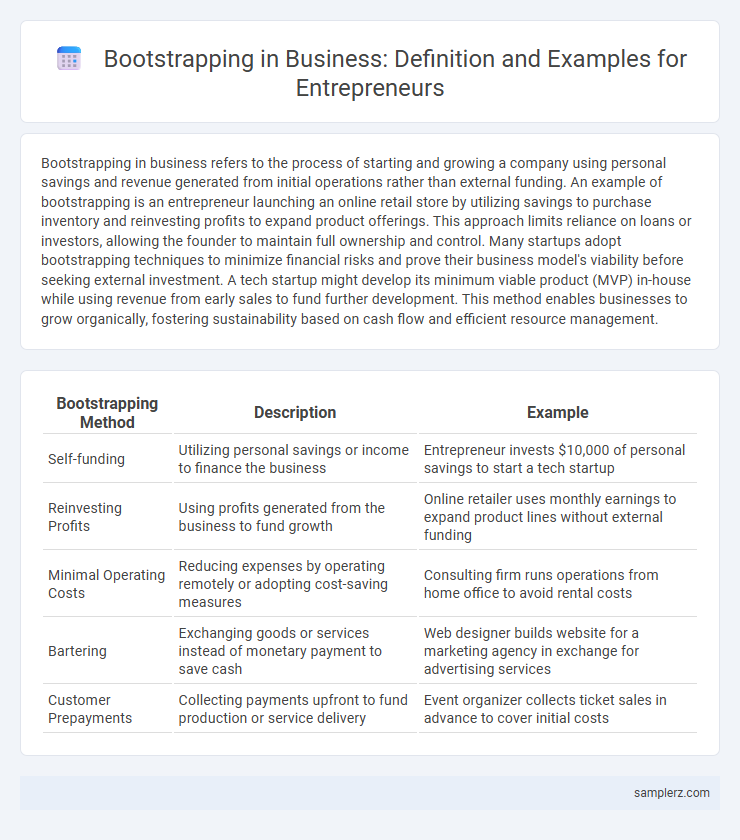Bootstrapping in business refers to the process of starting and growing a company using personal savings and revenue generated from initial operations rather than external funding. An example of bootstrapping is an entrepreneur launching an online retail store by utilizing savings to purchase inventory and reinvesting profits to expand product offerings. This approach limits reliance on loans or investors, allowing the founder to maintain full ownership and control. Many startups adopt bootstrapping techniques to minimize financial risks and prove their business model's viability before seeking external investment. A tech startup might develop its minimum viable product (MVP) in-house while using revenue from early sales to fund further development. This method enables businesses to grow organically, fostering sustainability based on cash flow and efficient resource management.
Table of Comparison
| Bootstrapping Method | Description | Example |
|---|---|---|
| Self-funding | Utilizing personal savings or income to finance the business | Entrepreneur invests $10,000 of personal savings to start a tech startup |
| Reinvesting Profits | Using profits generated from the business to fund growth | Online retailer uses monthly earnings to expand product lines without external funding |
| Minimal Operating Costs | Reducing expenses by operating remotely or adopting cost-saving measures | Consulting firm runs operations from home office to avoid rental costs |
| Bartering | Exchanging goods or services instead of monetary payment to save cash | Web designer builds website for a marketing agency in exchange for advertising services |
| Customer Prepayments | Collecting payments upfront to fund production or service delivery | Event organizer collects ticket sales in advance to cover initial costs |
Real-World Bootstrapping Success Stories
Sara Blakely founded Spanx with just $5,000 in savings, transforming a simple idea into a global brand without external funding. Mailchimp began as a side project funded through client work, scaling to millions of users through reinvested profits. These real-world bootstrapping examples highlight how resourcefulness and strategic financial management can drive significant entrepreneurial success.
Innovative Bootstrapping Strategies in Startups
Innovative bootstrapping strategies in startups include leveraging customer pre-orders to finance production, thus minimizing reliance on external funding. Utilizing bartering systems to exchange services and products with other businesses enables startups to conserve cash while acquiring necessary resources. Emphasizing lean operations such as remote work and digital marketing reduces overhead costs, fostering sustainable growth during early business stages.
Famous Companies That Bootstrapped to Success
Mailchimp, a leading email marketing platform, famously bootstrapped its way to success by growing through reinvested profits without external funding. Basecamp, the project management software company, achieved profitability early and expanded solely with customer revenue, avoiding venture capital. Patagonia, the outdoor apparel brand, maintained full control by funding growth internally, emphasizing sustainable and customer-focused business practices.
Bootstrapping Case Studies: Lessons Learned
Mailchimp exemplifies successful bootstrapping by growing from a small startup to a leading email marketing platform without external funding, highlighting the importance of customer-focused product development and efficient resource management. Basecamp's founders reinvested profits and maintained a lean operation, demonstrating how prioritizing sustainability and control can drive long-term business success. These case studies underline that disciplined financial practices and innovation are critical lessons for entrepreneurs relying on bootstrapping strategies.
How Entrepreneurs Used Personal Funds to Launch Businesses
Entrepreneurs commonly use personal savings and credit cards to finance startup costs, avoiding external investors and maintaining full control. Examples include tech founders who launched software companies from home offices funded by their own income or freelancers who reinvested earnings into expanding service offerings. This self-funding approach reduces reliance on loans and equity dilution while demonstrating commitment to potential future investors.
Creative Cost-Cutting Examples for Bootstrapped Businesses
Bootstrapped businesses often leverage creative cost-cutting strategies such as bartering services with other startups, utilizing free or low-cost digital marketing tools like social media platforms, and adopting remote work to save on office expenses. Entrepreneurs may also repurpose existing resources, negotiate extended payment terms with suppliers, and focus on minimum viable products to minimize upfront costs. These innovative approaches enable businesses to maintain cash flow, maximize resource efficiency, and sustain growth without external funding.
Growth Tactics for Bootstrapped Businesses
Bootstrapped businesses often accelerate growth by leveraging customer referrals, optimizing cash flow management, and prioritizing digital marketing strategies with low overhead costs. Implementing lean operations enables sustained expansion while maintaining financial independence from external investors. Focusing on product-market fit and iterative development drives customer retention and scalable revenue growth without heavy capital expenditure.
Bootstrapping Versus Venture Capital: Case Comparisons
Bootstrapping in business often involves founders using personal savings, reinvested profits, and resourcefulness to grow their companies without external funding, exemplified by companies like Mailchimp, which scaled to a multimillion-dollar valuation independently. In contrast, venture capital-backed startups, such as Uber, rely on substantial external investments to accelerate growth, enabling rapid market expansion but often at the cost of equity and decision control. Comparing these models highlights trade-offs between financial independence and rapid scaling potential, influencing strategic business decisions based on industry dynamics and founder goals.
Lean Operations: Examples from Bootstrapped Companies
Bootstrapped companies like Basecamp and Mailchimp exemplify lean operations by minimizing overhead costs and maximizing resource efficiency. These businesses prioritize essential expenses, utilize remote teams, and focus on iterative product development to reduce waste and accelerate growth. Lean practices enable sustained profitability without reliance on external funding or large-scale infrastructure.
Scaling Up Without Investors: Bootstrapping Journeys
Entrepreneurs scaling up without investors often rely on bootstrapping techniques such as reinvesting profits, leveraging personal savings, and optimizing cash flow management to fuel growth. Companies like Mailchimp and Basecamp exemplify successful bootstrapping by prioritizing customer-funded operations and maintaining lean overhead costs. These strategies enable sustainable expansion while preserving full ownership and control over business decisions.

example of bootstrapping in business Infographic
 samplerz.com
samplerz.com